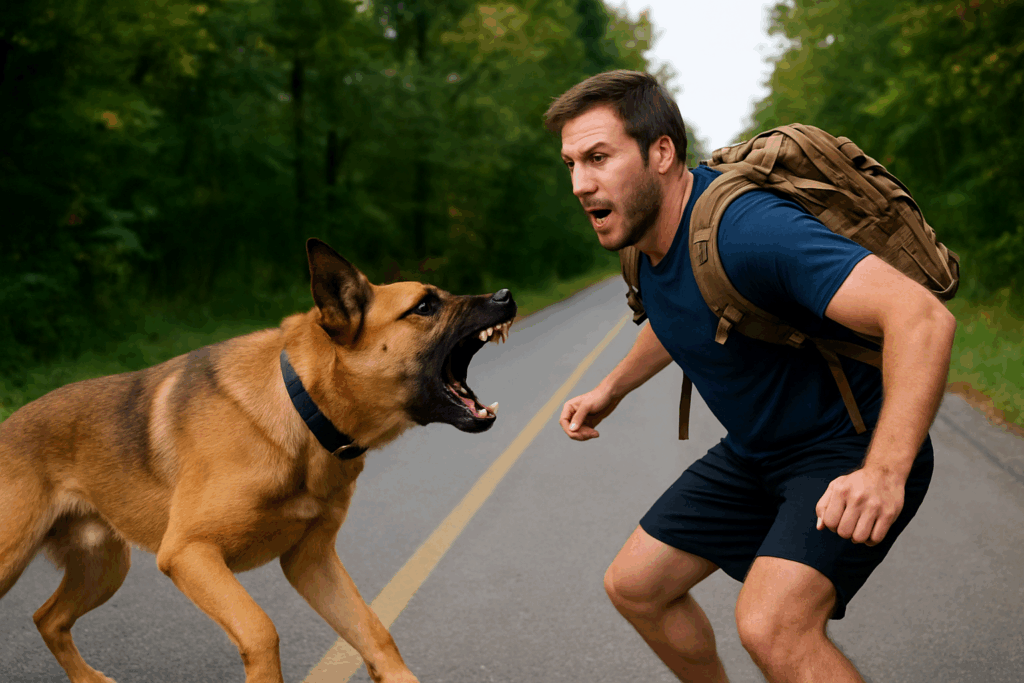Best Dog Defense for Ruckers, Runners, and Walkers

Introduction
Encounters with aggressive or off-leash dogs are a concern for anyone who spends time outdoors. Whether you’re rucking with a weighted backpack, running for fitness, or walking for relaxation, an unexpected dog confrontation can be both frightening and dangerous. Even friendly dogs can become unpredictable when startled, territorial, or overly protective.
As rucking continues to grow in popularity and more people take to sidewalks, trails, and parks, the chances of crossing paths with dogs—both leashed and unleashed—naturally increase. Suburban neighborhoods with patchy leash enforcement, rural backroads with free-roaming farm dogs, and city streets with crowded parks all present unique risks.
This guide explores practical strategies to keep yourself safe. We’ll cover prevention methods, defensive mindset and techniques, recommended gear, training, and the legal and ethical considerations around self-defense against aggressive dogs. The goal isn’t to escalate or harm animals but to equip you with the knowledge and confidence to handle a worst-case scenario if one arises.
Understanding the Risk
Dog encounters can happen anywhere—on a quiet neighborhood walk, during an early morning trail run, or while rucking through rural areas. The most common scenarios include dogs escaping fenced yards, owners walking off-leash without proper control, or stray dogs roaming freely.
Aggression is often rooted in instinct. Dogs may perceive ruckers and runners as intruders, especially near homes or property lines where territorial behavior is strongest. The rhythmic, fast movement of a runner or the bulky appearance of a rucker can trigger pack instincts in certain breeds. In some cases, dogs are not inherently aggressive but become defensive when startled or protective around their owners.
Stray or feral dogs, though less common in urban areas, pose additional challenges because they lack training and may act unpredictably. For ruckers and runners especially, speed, heavy breathing, and gear can make them appear as threats or prey, increasing the likelihood of being chased or confronted.
Recognizing these risks is the first step in preparing for safe outings.
Prevention First: Avoidance Strategies
The best defense against an aggressive dog encounter is prevention. Choosing your routes wisely can dramatically reduce risks. Stick to well-maintained parks, sidewalks, and neighborhoods with visible leash-law enforcement. Avoid isolated areas known for stray dogs or poorly fenced properties.
Situational awareness is equally important. Headphones can block out the sound of barking or footsteps, leaving you unprepared. If you listen to music, keep the volume low or leave one earbud out. Similarly, good visibility—whether in daylight or with reflective gear—helps you spot dogs before they spot you.
Learning to read canine body language also pays off. Raised hackles, stiff posture, intense staring, or growling are early warning signs of aggression. If you notice these behaviors, stop or change direction before the dog closes distance.
If you do find yourself confronted, your body language matters. Avoid direct eye contact, which can be seen as a challenge, and instead angle your body slightly to the side. Slow, calm movements show that you are not a threat. These small adjustments can prevent escalation and buy time to remove yourself safely.
Defensive Mindset and Techniques
When prevention fails, mindset becomes your strongest tool. Staying calm under pressure helps you think clearly and avoid panic, which can escalate a dog’s aggression. Take deep breaths and remind yourself that most confrontations do not end in bites if handled correctly.
Commands can be surprisingly effective. Using a firm, deep voice to say “No!” or “Go home!” may tap into a dog’s training or natural instincts to back down. Yelling in panic, however, can excite the animal further.
Your positioning also matters. If possible, put your ruck, backpack, or even a water bottle between you and the dog as a barrier. If carrying trekking poles, hold them out in front to create space. The goal isn’t to strike unless absolutely necessary but to protect yourself and show the dog that advancing will be difficult.
Practicing these techniques builds confidence, ensuring that if a dog charges, you know how to react without hesitation.
Recommended Dog Defense Tools
Pepper Spray / Dog Spray
- Top Pick: SABRE Dog Spray – a humane formula specifically designed for dogs, effective at stopping aggressive behavior without causing lasting harm.
- Pros: Lightweight, proven effective, affordable, and compact.
- Cons: Requires accurate aim under stress; wind can reduce effectiveness.
Ultrasonic Devices
- Top Pick: DAZER II Ultrasonic Dog Deterrent – one of the most trusted options, used by joggers and postal workers.
- Note: I used to ruck with this and once I used it at a big charging dog and the ultrasonic sound only made him more angry. Fortunately his owner was there and got him before he got within a few feet of me. If not, I was about to go crazy on him!
- Pros: Non-harmful deterrent that can stop dogs from approaching at a distance.
- Cons: Doesn’t work on all dogs; requires charged batteries, and is bigger than I prefer.
Walking Sticks / Trekking Poles
- Top Pick: Black Diamond Trail Trekking Poles – sturdy, lightweight, and reliable.
- Pros: Multi-use tool—helps with rucking posture, hiking stability, and doubles as a defensive barrier.
- Cons: Less practical for runners.
Personal Alarms
- Top Pick: SABRE Personal Alarm with LED Light – emits a 130dB alarm, startling to dogs and humans alike.
- Pros: Compact, effective in populated areas, draws attention quickly.
- Cons: May not stop a determined dog on its own.
Ruck/Equipment Adaptation
- Use what you’re already carrying. A ruck can be placed between you and a charging dog, dropped as a distraction, or swung as a shield if needed.
- Pros: Always available, no extra gear needed.
- Cons: Limited reach; requires quick reflexes.
Training and Preparedness
Owning deterrent tools is only part of the equation. Practicing with them before you hit the trail ensures you’ll know how to use them under stress. Try drawing your spray, activating your alarm, or positioning your trekking poles quickly during drills at home.
Confidence comes from repetition. Practice using your chosen tool with both hands and while moving, so muscle memory kicks in during a real encounter. The more familiar you are with your gear, the less likely you’ll freeze in the moment.
Preparedness also includes mental rehearsal. Visualizing scenarios and how you’d respond builds a calm, ready mindset, which can make all the difference if confronted.
Legal and Ethical Considerations
Before carrying deterrent tools, check your local laws. Some regions regulate the type of spray or device allowed. Using tools responsibly means aiming to deter, not cause unnecessary injury. Canine-specific sprays, for example, are formulated to be effective without long-term harm.
It’s also important to remember that not all dogs are truly aggressive—some may simply be startled or protective. Escalation should always be the last resort.
If you encounter consistently aggressive or uncontrolled dogs, report them to local animal control. This not only protects you but helps prevent future incidents for others in your community.
Conclusion
For ruckers, runners, and walkers, prevention remains the best defense against dog encounters. Smart route planning, awareness, and calm body language stop most problems before they escalate. Still, being prepared with the right tools and training provides peace of mind and a clear plan of action if an aggressive dog does approach.
Choose one deterrent that fits your routine, practice with it, and commit to carrying it regularly. While serious encounters are rare, readiness ensures you can focus on enjoying your workout or walk with confidence.
